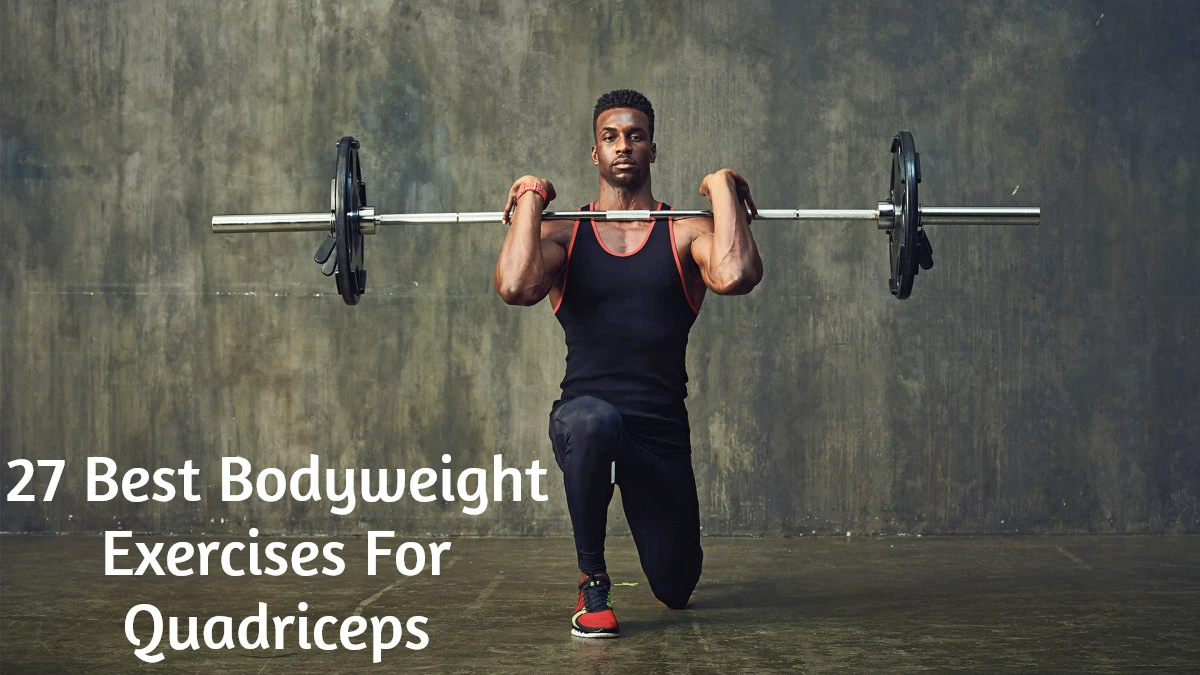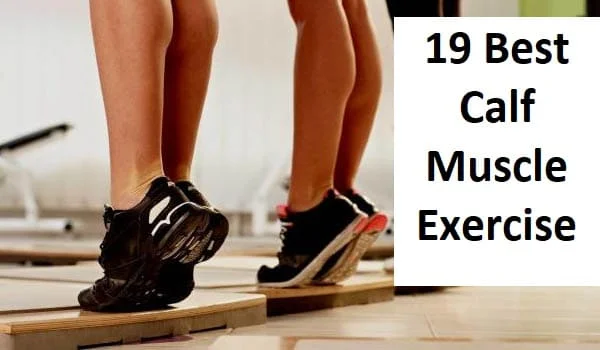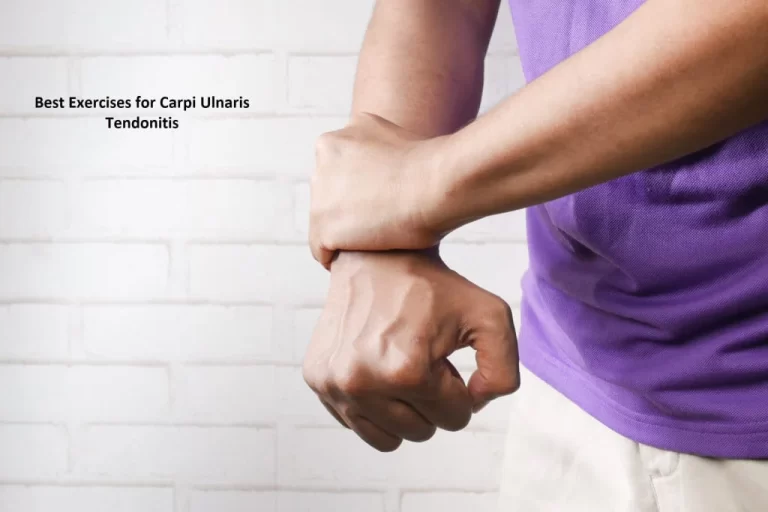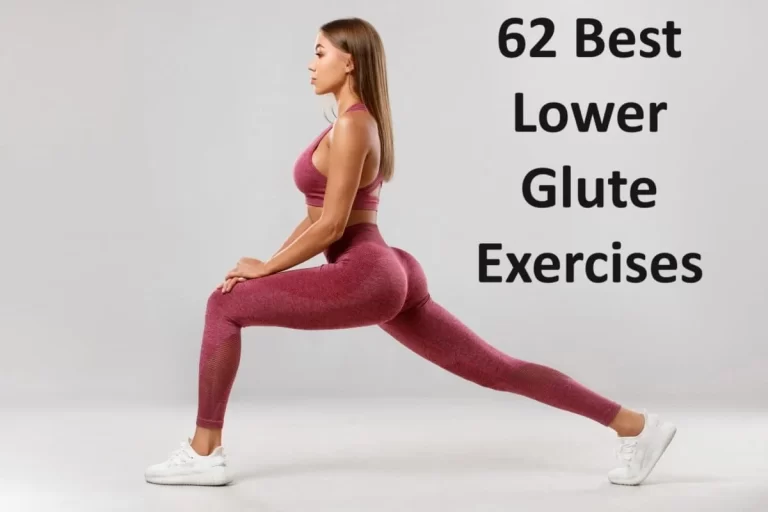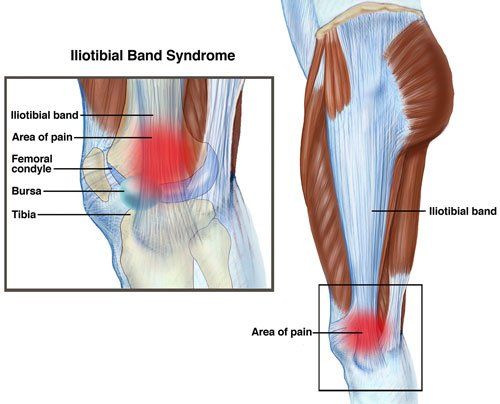27 Best Bodyweight Exercises For Quadriceps
Introduction
Bodyweight Exercises For Quadriceps
The majority of quad workouts are reasonably simple for beginners and don’t require any specialized equipment. Your quads are a crucial muscle group to focus on whether you’re a professional athlete or just starting out in fitness.
The muscles in question are needed for anything from standing up from a chair to sprinting or walking. Maintaining the strength of your quadriceps can help to stabilize your kneecaps and lessen the strain on your knees.
It can also enhance your athletic ability in a variety of ways.
Luckily, creating a workout program for your quads doesn’t take much time or effort.
Actually, you may work this muscle group with a lot of workouts that just use your body weight.
This post will go over ten of the greatest workouts you can do at home to build and tone your quadriceps.
What functions do the quadriceps muscles serve?
- The muscles on the front of your thighs are called your quads, or quadriceps femoris.
- The quadriceps are composed of four muscles: the rectus femoris, vastus lateralis, vastus medialis, and vastus intermedius.
- When you kick a ball and straighten your leg, you are causing knee extension, which is mostly controlled by your quadriceps muscles.
- The quadriceps are also important for hip flexion, which is the action of bringing your leg up to your chest, as in riding a bike.
- If you spend a lot of time sitting down and don’t regularly engage in strength training, your quadriceps may deteriorate.
- However, due to ordinary daily motions, most people generally tend to overuse their quadriceps and underuse their glutes: The front of our legs is used more than the back when we move forward.
- As a result, while strengthening exercises for weak quadriceps are crucial, don’t forget to dedicate some time to exercising your hamstrings and glutes as well. (Due to #balancing.)
What’s the best way to strengthen your quadriceps?
- Your quads will be worked in pretty much any activity that requires you to bend your knee.
- Sticking to bodyweight leg exercises can be difficult enough for a novice, but adding external resistance, such as free weights, is necessary for more experienced exercisers.
- To truly build strength, barbells, kettlebells, and dumbbells are all excellent choices.
- Squats and lunges rank highly on the list of the greatest exercises for strengthening the quadriceps.
- This is because they require both hip flexion and knee extension.
- They also require little equipment and are simple to perform at home or in the gym.
- If you’re not a big fan of squats, you can still build your quads without them: You can target that area with a variety of additional exercises, such as the leg press, step-up, lunge, and leg extension.
- Remember that there are numerous versions of these as well, such as step-ups to knee drive, walking lunges, and kneeling leg extensions, so you don’t have to perform the same leg exercises every workout. (In addition, there are other squat varieties; you might discover that you enjoy some but not others.)
What are the benefits of quadriceps exercises?
Your quadriceps, also called your quads, are made up of the following four muscles:
- Rectus Femoris. The primary muscle that aids in hip flexion is this one, which extends from your hip bone to your kneecap.
- Vastus Lateralis. This muscle travels down the outside of your thigh and is the largest of the four quadriceps. It links the top of your knee to your thighbone.
- Vastus Intermedialis. This muscle, which is found on the front of your thigh, is utilized to stabilize your kneecap and extend your knee.
- Vastus medialis. This muscle, which is situated between the other two vastus muscles on the front of the leg, is also responsible for extending your knee. Extending your knee and flexing your hip may become simpler with regular quad-strengthening workouts. Increasing your quadratic strength may also help.
- improve the stability of your kneecap
- protect your knee joint from injury
- increase your jump height
- improve your overall athletic ability
- lower your risk of developing knee osteoarthritis
- improve your balance and stability
- Facilitate commonplace motions including sitting, bending, and walking.
How do quadriceps exercises fit into a fitness routine?
- Plan to work this area during a full-body strength regimen or on a lower-body day (if you choose to split your workouts) because most exercises that target the quadriceps also hit other lower-body muscles, such as the hamstrings and glutes.
- A typical rule of thumb is to use a weight you can lift for roughly six reps per set with the correct technique if your objective is to gain substantial strength and aim for three to five sets of each exercise.
- You should use a weight that is appropriate for your level of experience and aim for 6 to 12 repetitions and one to three sets if you are just getting started with lifting or are just curious about the overall health advantages of strength training.
- Your quad workouts may need to be more challenging if you can perform far more repetitions and sets than these suggested ranges.
- While increasing the weight is a simple method to intensify a leg workout, if you strength train at home and lack access to a wide variety of weights, you do have other possibilities.
- If so, you can add difficulty to your quad exercises by slowing down, extending your range of motion, and doing more single-leg work to provide a balance problem.
- Before we go into our list of must-try exercises, let me just warn you: even though building those muscles can support your knees, if you are experiencing true knee discomfort, consult a physician or physical therapist before attempting any of the following exercises.
- They can provide you with advice on whether or not you should perform the quad-strengthening exercises listed below.
27 Best Bodyweight Exercises For Quadriceps
- All of the following exercises can be done without any equipment in the comfort of your own home.
- Dumbbells or other household items like books or water jugs can be used to increase the difficulty of some of these workouts.
Getting started
- Warming up for at least five to ten minutes is a good idea before beginning any of the quad exercises in this article.
- You can jog or walk quickly as part of your warm-up, or you can perform dynamic mobility exercises like arm or leg swings.
- For most of these exercises, if you’re a beginner, start with two sets of 10–12 repetitions.
- You can increase the number of sets or repetitions to make the workouts harder as they get easier to perform over time.
Bodyweight squat
One of the best total-body workouts for developing your lower body and core is the bodyweight squat. You can make the workout easier by shallowing the squat if you find it too difficult initially.
Muscles worked: quadriceps, hamstrings, gluteal, core, spinal erectors muscle
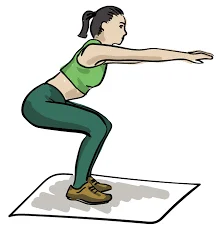
Steps To Follow:
- When standing, spread your feet shoulder-width apart and point your toes slightly outward.
- You can clasp your hands in front of you, keep your arms at your sides, or position your hands on your hips.
- Push your hips back as though you’re sitting in a chair while maintaining a strong core and an elevated chest.
- Once your thighs are parallel to the floor, stop and take a brief break.
- Up until you reach your starting posture again, push through your heels.
Useful Tips
- Keep your knees from collapsing inward.
- Avoid rounding your back by merely lowering yourself as much as you can.
- Maintaining your knees in line with your feet is a goal.
Walking lunge
A basic workout that strengthens your legs and core is the walking lunge. It’s easier if you only lunge halfway down. You can use dumbbells to increase the difficulty.
Muscles worked: quads, hamstrings, glutes, core
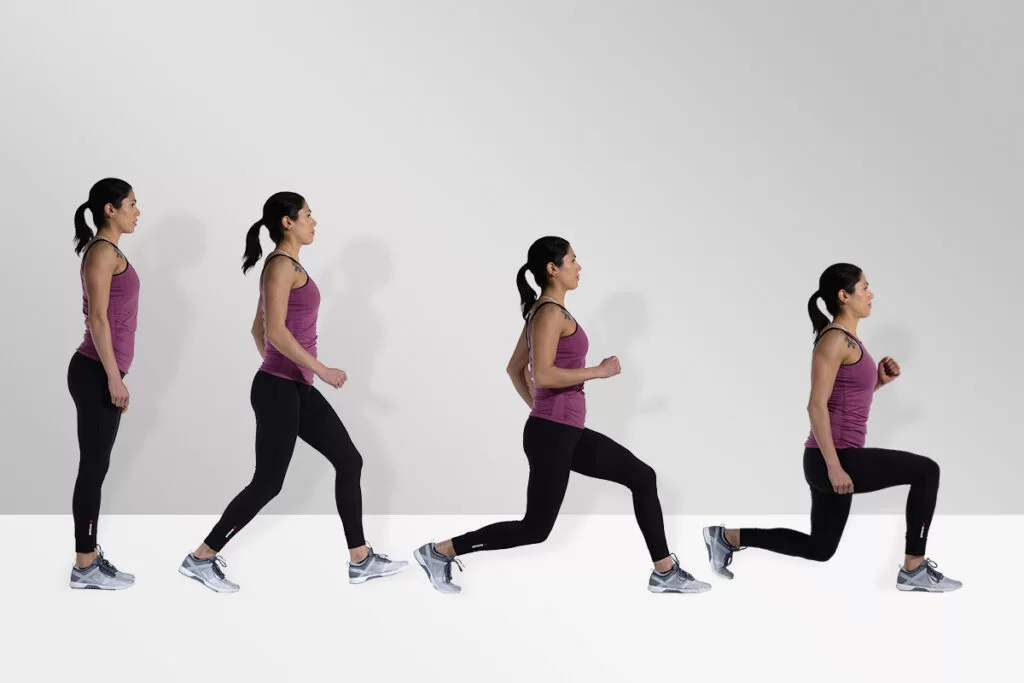
Steps To Follow:
- Keep your feet shoulder-width apart.
- If you’re holding dumbbells, keep your hands by your sides or place them on your hips or chest.
- With one foot, take a step forward and lower yourself until your back shin is parallel to the floor and your front knee is at a 90-degree angle.
- Take a moment to compose yourself before launching yourself forward with your opposing foot.
- As you lunge forward, keep switching sides.
Useful Tips
- Refrain from touching the ground with your rear knee.
- Make an effort to keep your knee in line with your toes, not over them.
- Should you get knee pain, stop.
Step-up
One excellent exercise to strengthen your knee stabilization is a step-up. The exercise is easier when done with a lower box.
Muscles worked: quads, hips, hamstrings, calves, core

Steps To Follow:
- Look for a knee-high solid surface, such as a step or box.
- Step up with one foot planted firmly on the object, being careful not to allow your knee to buckle inward towards your ankle.
- As you take a stride up, concentrate on pressing through your heel and maintain a tall stance while pushing your opposing knee up until it is hip-distance apart.
Useful Tips
- Verify that the item you’re walking on is stable and cannot slide out from under you.
- Make sure nothing is in the way of you.
- Make sure you have at least one free hand when utilizing a weight.
Bulgarian split squat
Compared to standard squats, Bulgarian split squats place greater focus on the stabilizing muscles of your hip and knee. If you only go halfway down, you can ease them.
Muscles worked: quads, hamstrings, hips, core
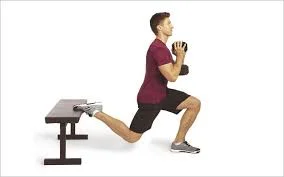
Steps To Follow:
- Place yourself around two steps away from a bench, box, or other knee-high object, with your feet shoulder-width apart.
- Step your front foot forward so that you may squat without your knee going past your toes, resting the top of one foot on the object behind you.
- Bend slightly forward and lower yourself until your front thigh is almost parallel to the floor.
- Repeat on the opposite side after completing the desired number of repetitions.
Useful Tips
- Verify that the thing behind you is stable and firm.
- If you have any knee pain, stop.
Lateral lunge (side lunge)
The lateral lunge works your inner thigh as well as your quadriceps.
Muscles worked: quads, inner thigh, hamstrings, glutes
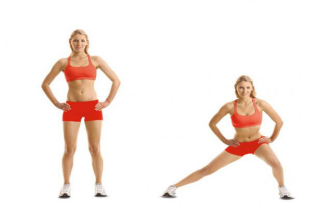
Steps To Follow:
- As you stand, place your arms in front of you for balance and your feet shoulder-width apart.
- Step sharply to the right, bending your right knee to bring yourself into a squat.
- Then, start pulling your hips back.
- Once your thigh is parallel to the floor, squat as low as is comfortable.
- Go back to the beginning
- and repeat the process on the opposite side.
Useful Tips
- Steer clear of taking steps that cause you any groin pain.
- When you squat down, keep your knee above your second and third toes.
- When you’re going back to the beginning position, try not to twist.
Squat jump
One of the best exercises for strengthening your lower body is the squat jump. You can begin this exercise by doing 5 reps each set rather than 10.
Muscles worked: glutes, quads, calves, core
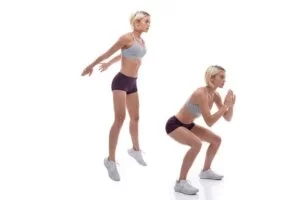
Steps To Follow:
- With your hands in front of you and your feet shoulder-width apart, take a squat stance.
- Lean in until your thighs are nearly parallel to the ground, then leap up with force.
- Before repeating, gently land and bend your knees a little.
Useful Tips
- Avoid squat jumps if you have knee issues.
- Bend at the knees to try to make the landing as soft as possible.
- Keep your knees inside your toes when landing.
Box jump
Another excellent exercise for building lower body power is the box jump.
For this exercise, it’s important to limit yourself to roughly 5 repetitions since as you grow weary, the likelihood of damage increases.
Muscles worked: quads, calves, glutes, core
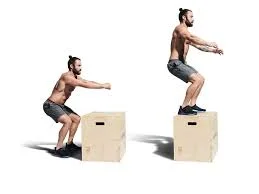
Steps To Follow:
- Step with your feet shoulder-width apart, about a foot away from a solid box or other steady surface.
- To enter a quarter squat, bend your knees and lower your arms behind you.
- Lean your hips forward, swing your arms forcefully, and leap up onto the box.
- Bend your knees slightly when you land.
- Restart after stepping down.
Useful Tips
- Box jumps should be avoided if you have knee problems.
- Selecting a box that is too low is preferable to one that is too high, particularly for novices.
- Remember to bend your knees to provide some cushion for your jumps.
Reverse lunge
Reverse lunges are a variation on the classic lunge that increases the stability of your lead leg, which helps with balance. To make them easier, only make a halfway decent lunge.
Muscles worked: quads, glutes, core
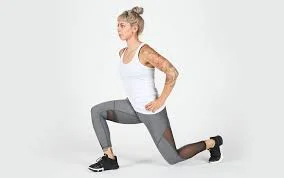
Steps To Follow:
- Grasp dumbbells at your sides or place your hands on your hips to stand tall.
- Step back with one foot in a major way.
- Once your lead thigh is parallel to the floor, lower yourself.
- The rear knee should be nearly in contact with the ground.
- As you take a step back to the beginning, push through your front heel.
- Repeat, switching sides each time, for the desired number of repetitions.
Useful Tips
- Refrain from touching the ground with your rear knee.
- If your knees start to hurt, stop.
- When you lunge, keep your front knee over your toes but not past them.
Single-leg raise
The area of your quads that crosses your hip joint, the rectus femoris, is the focus of the single-leg raise.
Muscles worked: rectus femoris, hip flexors, core
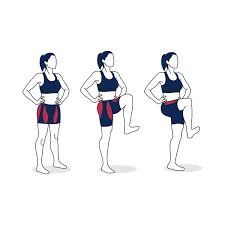
Steps To Follow:
- With your legs extended straight in front of you, lie on your back.
- With one foot flat on the ground, angle your knee to 90 degrees.
- Raise your straight leg until the angle of your thigh equals the angle of your opposite thigh, maintaining a taut core and straight leg.
- After you’ve completed the desired amount of repetitions, go back to the beginning position and swap legs.
Useful Tips
- Maintain your core rigid.
- Refrain from locking your straight leg’s knee.
Single-leg squat (pistol squat)
A difficult squat variation that calls for strength, agility, and balance is the pistol squat. You can restrict how low you can go by placing a chair behind you if you are unable to squat fully. This exercise is not appropriate for beginners. It’s advisable to attempt this exercise only when you can complete the preceding nine exercises with ease.
Muscles worked: quads, glutes, core, inner thigh
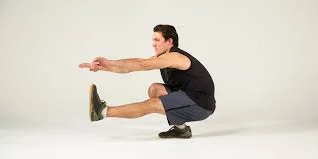
Steps To Follow:
- Arms extended in front of you, feet together, take a proud stance.
- Elevate one foot off the ground and maintain a straight leg position in front of your torso.
- Squat on the second leg as soon as your thigh is parallel to the floor.
- Repeat with the other leg, going back to the beginning position.
Useful Tips
- If you get knee pain, stop.
- Only descend as far as you are comfortable.
- Only descend as far as it allows you to maintain knee control.
Quadruped Rocking
This pose is a wonderful way to stretch your quads and hips because it combines two well-known yoga poses: child’s pose and cow.
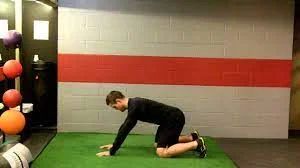
Steps To Follow:
- While on all fours, let your lower back to sag.
- Keeping your lumbar arch in place, push your hips back as far as you can.
- A stretch in and around your hips should be felt.
- Go back to the beginning and do it again.
- Ten reps in two sets, with a 30-second break in between.
Split Squat
This unexpectedly difficult exercise strengthens and balances the entire leg, which targets your quadriceps.
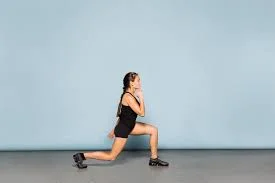
Steps To Follow
- With your arms by your sides, take a lunge.
- Drop your hips by squatting all the way back.
- Drive your front leg back up to regain your weight without allowing your back knee to make contact with the ground.
- 30 seconds should elapse between each of the two sets of 10–15 repetitions on each side.
Lateral Bound
Although forward-jumping exercises are commonly used to evaluate the quadriceps, this exercise will push you to develop lateral power.
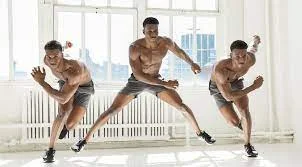
Steps To Follow:
- Keeping your left foot off the ground, stand on your right leg.
- By slightly squatting on your right leg, you can jump laterally to the left by using your quads and glutes.
- Keeping your balance, land on your left leg.
- For three seconds, hold. Repeat, hopping to the opposite side, with your left leg.
- Ten repetitions on each side in two sets, with a 30-second break in between.
Wall Sit
Until you attempt it, it appears simple. This test of pure willpower and leg strength is going to leave your quadriceps scorching in no time.
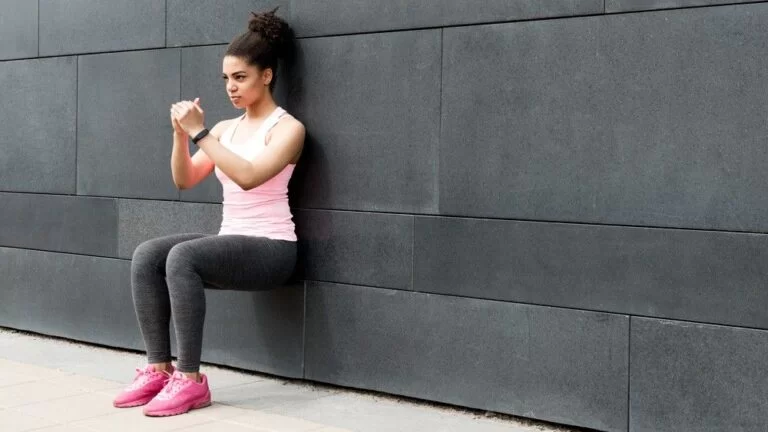
Steps To Follow:
- Put one foot in front of the wall.
- With your back flat against the wall, assume the position of an unseen chair.
- Two sets of 30 seconds each, interspersed with a 30-second break, or as long as feasible.
180° Squat
This exercises your quadriceps and enhances hip stability and mobility.
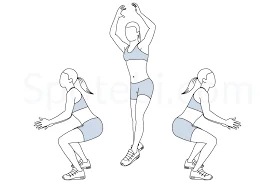
Steps To Follow:
- Jump 180 degrees to the left after squatting.
- Assume that you wish to face the mirror that is behind you.
- Now jump back the way you came, squatting with your back to the mirror.
- Once more, squat, then leap to the right.
- Continue doing this for the required number of reps.
- 30 seconds of rest in between each of the two sets of 10.
Goblet Squat
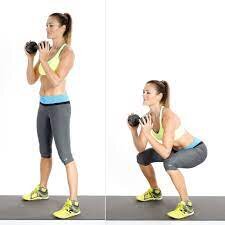
Steps To Follow:
- Hold a dumbbell in front of you with both hands so that it hangs vertically while standing with your feet slightly wider than hip-width apart and your toes slightly turned out.
- Maintain an elevated chest and flat back while bending your knees to drop into a squat, pushing your hips back, and contracting your core as you shift your weight into your heels.
- Once you’ve driven through your heels, squeeze your glutes.
Eccentric Squat
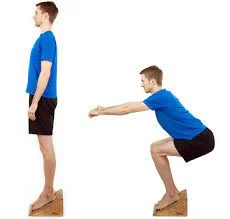
Steps To Follow:
- Place your hands at breast height, your core tight, and your feet hip-width apart.
- You can also carry one dumbbell in front of your chest or two loaded on your shoulders for an extra challenge.
- To complete a three-second drop into a squat, gently draw your hips back and bend both knees until your thighs are parallel to the floor.
- At the bottom of the movement, pause for a moment, then quickly come back to standing by pressing through your heels.
- It will be more difficult when you pause at the bottom.
- That amounts to one rep.
Kneeling Leg Extension

Steps To Follow:
- Place your hands on your hips, knees hip-distance apart, body tall, legs and core engaged, and knees facing each other.
- This is where everything begins.
- As you progressively tilt your torso backward until your butt is a few inches away from your heels, maintain a flat back and extended hips.
- To get back to where you were before, pause and then carefully reverse the motion.
- This is one repetition.
Forward Lunge
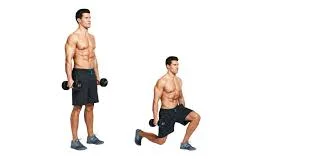
Steps To Follow:
- Place your feet hip-width apart and tense your core.
- To take a lunge, step forward with your right foot and bend both knees to a 90-degree angle.
- In order to get back to where you were, push off your right foot.
- Continue on the opposite side.
- This is one repetition.
Wide Squat to Narrow Squat
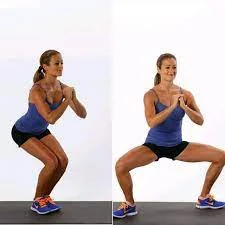
Steps To Follow:
- Place both ends of a dumbbell horizontally at chest height, stand with your feet hip-width apart, and contract your core.
- From this narrower position, squat by bending both knees and thrusting your hips back.
- If this squat isn’t as deep as your other squats, that’s acceptable.
- Take a standing stance again.
- With your right foot, now take a broad step to the right.
- Send your hips back and plant your feet far apart to perform another squat.
- You might discover that slightly spreading your toes apart makes them more comfortable.
- Get back up to your starting position and perform another narrow squat.
- Step out wide with your left foot on your subsequent broad squat.
- For your broad squats, keep switching up whatever foot you step out with.
Reverse Lunge to Knee-Up Jump
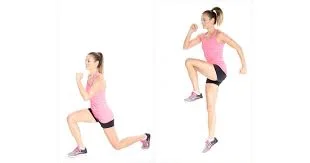
Steps To Follow:
- Keep your feet shoulder-width apart, stance upright, and contract your core.
- With your right foot, take a step backward, landing on the ball of your foot and lifting your right heel off the ground.
- As you descend into a lunge, flex both knees to a 90-degree angle. Bend the elbows of your right and left arms as you swing them forward and slightly back, respectively.
- Don’t protrude your butt; instead, keep your hips tucked in and your core active.
- To jump as high as you can, push through your left foot and bring your right knee up to your chest.
- Gently plant your left foot, then plunge right back into another lunge.
- That amounts to one rep.
Single-Leg Squat to Chair

Steps To Follow:
- Place your feet shoulder-width apart, foot one foot slightly ahead of the other, and face a strong chair with your back to it.
- Make a fist with your hands and hold it in front of your chest.
- The heels on your back should be in line with the chair legs.
- This is where everything begins.
- To descend into a squat, brace your core, put your weight into your back heel, push your hips back, and bend your back knee.
- Straighten and lift your front leg as you lower your butt to the chair.
- Place your hand on the chair’s butt and take a seat.
- Squeeze your glute at the peak of the squat after pausing at the bottom and driving through your heel to stand.
- That amounts to one rep.
Sumo Squat
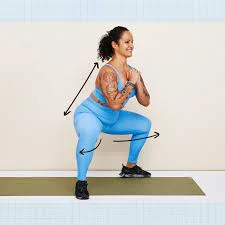
Steps To Follow:
- Place your feet wider than shoulder-width apart and point your toes about 45 degrees out from the body.
- Grasp a kettlebell by its horns using both hands. (A dumbbell can be used for this as well.) This is where everything begins.
- As you lower yourself into a squat, bend your knees and push your hips back.
- Squeeze your glutes at the top after driving through your heels to stand again.
- That amounts to one rep.
Curtsy Lunge

Steps To Follow:
- Position your hands in front of your chest or on your hips, and keep your feet shoulder-width apart.
- This is where everything begins.
- Step diagonally with your right foot behind you, bringing your right knee down to nearly the floor.
- It would help if you bent your front knee to a 90-degree angle.
- Put pressure on your left heel to get back up and take a starting stance.
- Continue on the opposite side.
- This is one repetition.
- Keep switching things up.
Barbell Front Squat

Steps To Follow:
- With your feet parallel and the bar resting on your collarbone and gently pressing against your throat, position yourself just underneath the bar to begin the front squat.
- With your fingers beside your body, your elbows bent and facing forward, your palms up, and your hands slightly wider than shoulder-width apart, grab the bar.
- Elevate your posture and move backward, away from the squat rack. Step your feet out by 20 to 30 degrees and place them slightly wider than shoulder-width apart.
- Next, drop yourself into a squat by pushing your hips back and bending your knees, extending your knees slightly to the sides.
- As small as your range of motion will allow, squat
- To get back up, push through both of your feet.
- That amounts to one rep.
Split Squat Jump
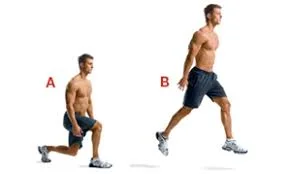
Steps To Follow:
- Step your left foot forward as if you were performing a forward lunge, keeping your left heel firmly planted. Place your feet underneath your shoulders and your hands at your sides.
- Bend both of your knees to bring your legs to a 90-degree angle.
- Your torso should be somewhat forward and your chest upright to guarantee that your back is flat and not rounded or arched forward.
- Your left knee should be over your right foot and your left quad should be parallel to the floor.
- Your butt and core are supposed to be in use.
- The split squat position is this.
- Jump as high as you can by pushing through your left foot and bringing your arms together in front of your chest.
Seated Leg Extension
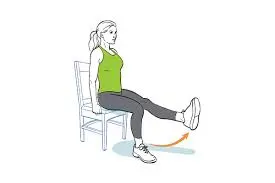
Steps To Follow:
- Place your back against the chair’s back while sitting up on the seat of a strong chair.
- This is the initial position.
- You can put an ankle weight around the working ankle to make this more difficult.
- Raise your right leg till it is straight out in front of you by contracting the quadriceps muscle. At the peak, pause.
- Lower your right leg back to the starting position slowly and deliberately.
Conclusion
Enhancing your quadriceps strength and tone can help your knee become more stable, lower your chance of suffering a knee injury, boost your sports performance, and make daily activities easier.
Without any specialized equipment, you can perform a variety of quad exercises at home. Increase the amount of repetitions or sets you complete as you get stronger and the movements get easier.
Consult your doctor before beginning a new exercise regimen if you’ve never worked out before, have an accident, or suffer from a chronic health condition.
FAQs
Can bodyweight exercises help develop quadriceps?
Despite popular belief, you don’t need to lift large weights to develop leg strength. While bodyweight leg workouts can assist build your quads, calves, and hamstrings, a set of dumbbells can also be a useful tool while training.
How can I increase the body weight of my quads?
Try more advanced varieties like the pistol squat, Bulgarian split squats, renegade pistol squats, and box pistol squats to create enormous quads. These variations on the squat will strengthen and increase your overall endurance while working your muscles from different angles.
Does riding a bike develop quads?
Cycling puts the most strain on the quadriceps, which are crucial to maintaining strength while riding.
Why do weak quads occur?
However, others have proposed that quadriceps weakness predates the beginning of knee osteoarthritis (OA) and is itself a risk factor for the development of knee OA, particularly in women. Quadriceps weakness may occur from the discomfort associated with osteoarthritis.
Is it easiest to create muscles in the quads?
Each person has a different simplest muscle group to build depending on their genetics, body type, and preferred style of training. But compared to other muscle groups, many people discover that building muscle in the legs especially the quadriceps is comparatively simpler.
References:
- Yetman, D. (2023, May 23). 10 At-Home Exercises to Strengthen and Tone Your Quads. Healthline. https://www.healthline.com/health/best-quad-exercises#bottom-line
- Williams, P. (2019, December 6). The 10 Best Bodyweight Exercises for Your Quads. Muscle & Fitness. https://www.muscleandfitness.com/workouts/leg-exercises/10-best-bodyweight-exercises-your-quads/
- McCoy, J., CPT, A. M. W., & CPT, C. S. (2023, December 6). 20 Quad Exercises That Will Seriously Work the Top of Your Legs. SELF. https://www.self.com/gallery/best-quad-exercises

